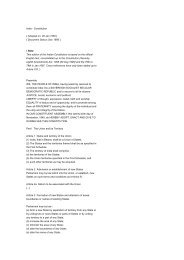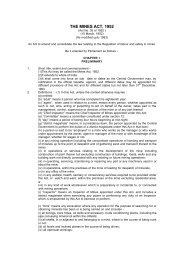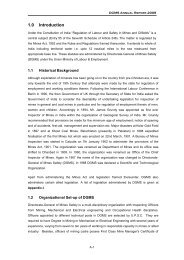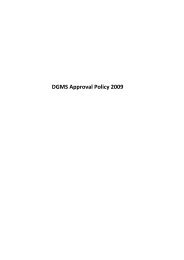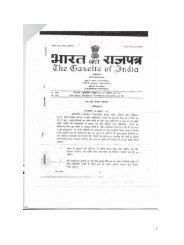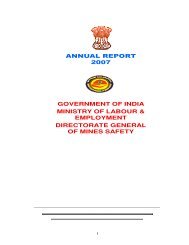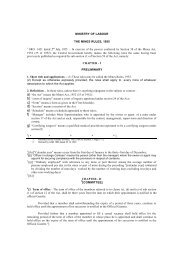Metalliferous Mines Regulations, 1961 - Directorate General of ...
Metalliferous Mines Regulations, 1961 - Directorate General of ...
Metalliferous Mines Regulations, 1961 - Directorate General of ...
Create successful ePaper yourself
Turn your PDF publications into a flip-book with our unique Google optimized e-Paper software.
(3)(a) Every stopping between the main intake and main return airways shall be<br />
constructed <strong>of</strong> masonry or brickwork, not less than 25 centimetres in thickness or<br />
such greater thickness as may be required by the Regional Inspector, and shall be<br />
faced with a sufficient thickness <strong>of</strong> lime or cement plaster to prevent leakage <strong>of</strong><br />
air.<br />
(c) Every stopping in use shall be kept accessible for inspection.<br />
(4) The partitions and walls <strong>of</strong> every air-crossing shall be not less than 25<br />
centimetres in thickness if constructed or masonry or <strong>of</strong> concrete not properly<br />
reinforced, and not less than 15 centimeters in thickness if constructed <strong>of</strong><br />
properly reinforced concrete.<br />
(5) Every air-crossing, ventilation stopping, door or brattice shall be maintained<br />
in efficient working order and good repair.<br />
(6) A competent person shall, once atleast in every 30 days, examine every<br />
airway, air crossing, ventilation stopping and door in use, an shall record the<br />
result there<strong>of</strong> in a bound paged book kept for the purpose, and shall sign the<br />
same and date his signature.<br />
136. Auxiliary fans.- (1) Every auxiliary fan :<br />
(a) shall be installed, located and worked in such a manner that –<br />
(i)<br />
(ii)<br />
a sufficient quantity <strong>of</strong> air shall, at all times, reach it so as to ensure<br />
that it does not re-circulate air; and<br />
there is no risk <strong>of</strong> the air which it circulates being contaminated by any<br />
substantial quantity <strong>of</strong> inflammable or noxious gases or dust; and<br />
(b) shall have an air-duct for conducting the air to or from the face or blind end;<br />
and such air-duct shall be so maintained as to minimise any leakage or air and<br />
to ensure an adequate supply <strong>of</strong> air to within 4.5 metres <strong>of</strong> the face or blind<br />
end.<br />
(2) No auxiliary fan shall be started, stopped, removed, replace or in any way<br />
altered or interfered with, except by or on the authority <strong>of</strong> an <strong>of</strong>ficial.<br />
(3) No person shall enter or remain in any place which is dependent for its<br />
ventilation on an auxiliary fan, unless such fan is operating efficiently.<br />
Whenever the ventilation <strong>of</strong> any such place has been interrupted, whether by<br />
the stoppage <strong>of</strong> the fan or otherwise, no person shall so enter or remain<br />
therein, except for the purpose <strong>of</strong> restoring the ventilation, unless the place has<br />
been examined by a competent person and declared safe.<br />
137. Precautions against fire in ventilation appliances. - The covering <strong>of</strong> every shaft,<br />
winze or rise sealed <strong>of</strong>f or covered for ventilation purposes, every fan drift, duct or casing<br />
an every part <strong>of</strong> a mechanical ventilator or fan within such drift, duct or casting, and<br />
every air-crossing an ventilation door shall be constructed <strong>of</strong> fire-pro<strong>of</strong> material :





